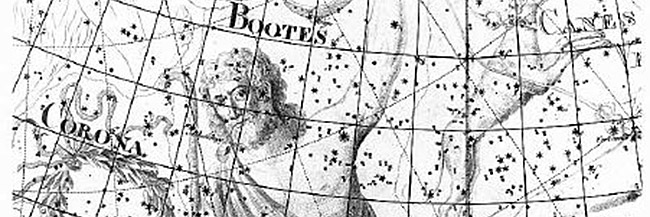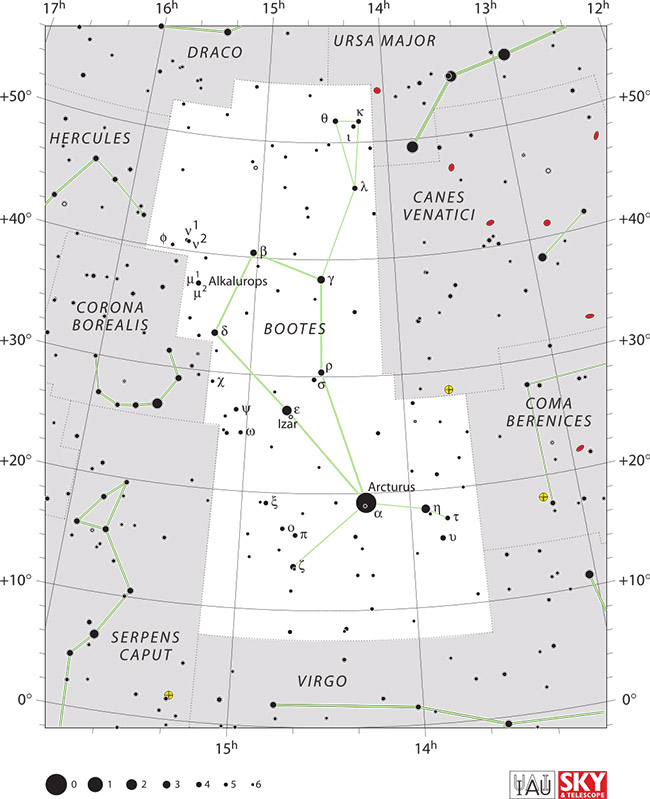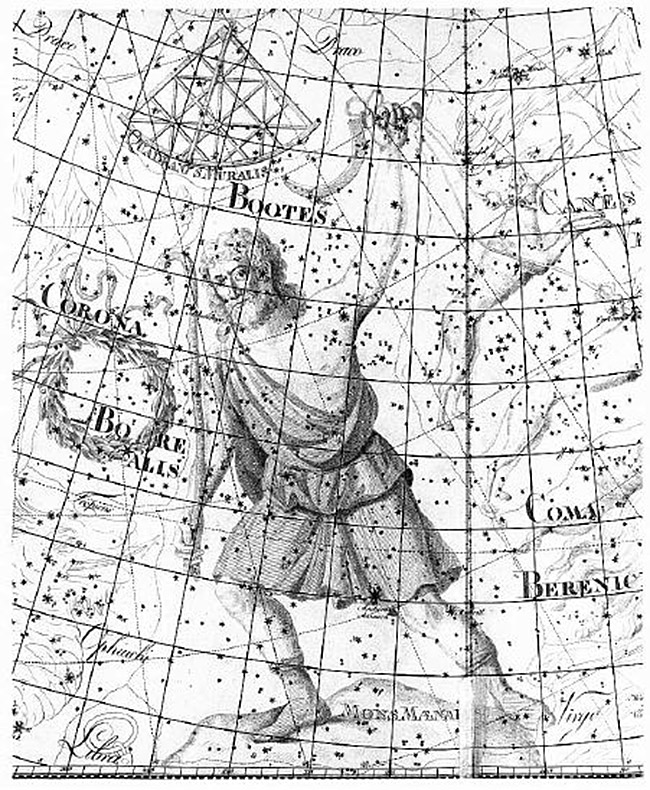Bootes – Constellation Facts

Bootes is the 13th biggest constellation in size and covers 907 square degrees. It can be viewed in the third quadrant of the Northern hemisphere and lies specifically at latitudes between +90° and -50°. To correctly say, Bootes, each “o” is pronounced separately, putting emphasis on the “tes.”
Constellation Characteristics
The major stars in Bootes form a loose rectangle/triangle pattern and it derives its name from the Greek origin meaning, plowman, ox driver or herdsman. Bootes neighbors with the constellations of Canes Venatici, Coma Berenices, Corona Borealis, Draco, Hercules, Serpens Caput, Virgo and Ursa Major. It does not contain any Messiers, but does have stars with known planets.

IAU and Sky & Telescope magazine (Roger Sinnott & Rick Fienberg), CC BY 3.0, via Wikimedia Commons
By IAU and Sky & Telescope magazine (Roger Sinnott & Rick Fienberg) CC BY 3.0, via Wikimedia CommonsPlanetary Systems
Bootes is home to three fascinating deep sky objects including a Supervoid, a Dwarf Galaxy and a Globular Cluster. Check them out;
- Bootes void: this Supervoid or the Great Void is spherical in shape and is now known to contain around 60 galaxies. It is also 250 light-years in diameter.
- Bootes Dwarf Galaxy: discovered in 2006, this faint dwarf spheroidal galaxy is about 197,000 light-years from here. It is also distorted in shape because it orbits the Milky Way. It is situated 720 light-years across.
- NGC 5466: discovered in 1784, this globular cluster is about 51,800 light-years from Earth. It is interesting because it contains a blue horizontal branch of stars.
Main Stars
The constellation Bootes contains nine significant stars. Read on to discover their amazing qualities.
- Arcturus (Alpha Boötis) is the brightest star in this constellation, which will be discussed later in detail.
- Nekkar (Beta Boötis) is also known as “Meress” and is a yellow G-type giant. Nekkar is also a “flare star” which means it will show shines of brilliant luminosity for brief periods of time.
- Seginus (Gamma Boötis) is considered a Delta Scuti type variable star, because it has degrees of luminosity due to radial and non-radial surface pulsations.
- Izar (Pulcherrima) ~ (Epsilon Boötis) is sometimes known as, Pulcherrima, which means “loveliness” in Latin. This star is binary in nature consisting of a bright orange giant and a fainter main sequence star.
- Muphrid (Saak) ~ (Eta Boötis) this star’s name originates from the Arabic phrase meaning, “the single one of the lancer.” It is close to Arcturus and is catalogued as a spectroscopic binary star.
- Alkalurops ~ (Mu Boötis) is derived from the Greek language (kalaurops) which means “the shepherd’s staff.” It is a triple star made up of a bright yellow-white F-type subgiant and a fainter binary star.
- Merga (38 Boötis) is located 153 light-years away and its name is derived from the Arabic pharse which means “the chained woman.” It is also catalogued as a spectral class F7IVw.
- Nadlat (Psi Boötis) is an orange K-type giant that is located about 250 light-years from Earth.
Tau Boötis is binary in nature; yellow-white dwarf and a dim red giant. The main star was discovered (in 1996) to have an extrasolar planet in its orbit.

Boötes on Chart VII of the Uranographia of Johann Bode (1801).
Boötes on Chart VII of the Uranographia of Johann Bode (1801).Most Shining Star
Out of all the stars that make up the Bootes constellation none shine brighter than Arcturus. This star is listed as the third individual brightest star in the night sky, shining at an apparent visual magnitude of -0.04. In fact, it shines 110 times brighter than our Sun and is classified as a K1.5 IIIpe orange giant. Arcturus derives its name from the ancient Greek language and means, “Guardian of the Bear,” because it is located in the left foot of the herdsman.
Mythology & History
The history of Bootes depicts this constellation as a herdsman with a club in one hand and his two leashed dogs in the other (Asterion and Chara; represented by Canes Venatici). It was once thought that the herdsman followed Ursa Major around the pole; his oxen are tied to the polar axis which keeps the stars in motion.
The most popular myth associated with this constellation; however, involves Zeus and his son Arcas. Arcas was raised by his grandfather (Arcadian King Lycaon). One day the king decided to test Zeus by killing Arcas and serving him to Zeus to eat. Zeus was enraged and turned the king into a wolf, then killed all his children with his lightning bolts. Zeus then brought Arcas back to life. As the myth goes on, Arcas was the product of an affair Zeus had with King Lycaon’s daughter, Callisto. When Zeus’ wife heard of this love-child she transformed Callisto into a bear. Years later, as Callisto roamed the woods, she came upon her son. Not realizing this was his mother, Arcas chased the bear until they ended up in a sacred temple. To avoid any further trouble, Zeus placed both of them in the sky; Callisto is Ursa Major and Arcas as Bootes.
Bootes is a fascinating constellation, so the next time you are gazing into the night sky be sure to search out this intriguing figuration of stars.
